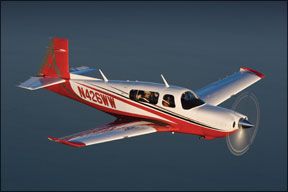As an aircraft company, Mooney has been down and out and resurrected more times than a dried-out Betty Ford graduate with a reserved parking space near the door. Nothing, it seems-not frightful market conditions, not inept management and not even great clouds of plastic airplanes-can drive a stake though the heart of what has to be the scrappiest airplane company in the universe. Thats due almost entirely to one thing: Mooneys are a fundamentally sound design.
Now comes Mooney with yet another reiteration in the new M20TN Acclaim. Straight to the
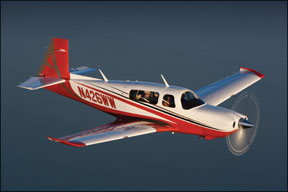
chase: The Acclaim is as good as anything Mooney has ever built, maybe better. Its among the fastest, if not the fastest, production piston airplane and its every bit the value of a new Cirrus or Columbia. Why Mooney doesnt sell more like three times more is a puzzlement to us. Cirrus may be right; maybe every airplane needs a parachute.
Heretofore, Mooneys recent slam dunk sales hit was the Ovation, which we always opined needed turbonormalizing to capitalize on its low drag, decent payload and generous fuel capacity. And thats exactly what the Acclaim is: a turbonormalized Ovation.
Airframe
Mooney unveiled the Acclaim at Sun n Fun in April 2006, but it took another 10 months to guide it through final certification. The Ovation/Acclaim airframes were
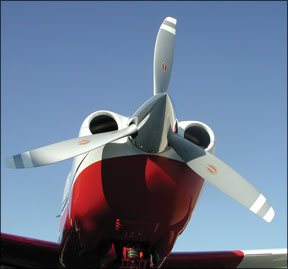
themselves adapted from the so-called long-body Mooneys that evolved during the late 1980s, from the Porsche Mooney project. The long body fuselage and wings were used in the TLS/Bravo, Mooneys last foray into the turbocharged market and one that received lukewarm acceptance.
The Acclaim is built the way all Mooneys have been from the dawn of time (almost): riveted aluminum over a welded steel tube cage with a hell-for-strong single-piece wing. The control system is activated by push-pull tubes, which are heavier than cables, but yield a more positive feel at the expense of some friction, especially in roll. Overall dimensions are nearly the same as the Ovation a 36-foot-6-inch wingspan and 26-foot-8 inch long fuselage. Minor airframe changes include largely cosmetic upswept wingtips and a carbon fiber cowling set that reduces weight forward.
Fuel is tankered where it always has been in sealed bays in the inboard portion of each wing, with a left/right/off fuel selector on the cabin floor. Given its empty
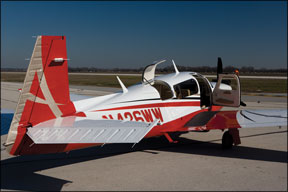
weight and engine fuel specifics, at 102 gallons, the Acclaim has generous fuel stores, in our view, although we think some owners will still want the long-range option, which stuffs in a bladder-busting 130 gallons, just the thing for serious transcon flying. Having paid for several Mooney tank reseal jobs, were not thrilled with the wet-wing design, but Mooney assures us that the newest sealant compounds have all but eliminated age-related tank leaks.
Systems wise, the Acclaim has the same electrical system as the Ovation, consisting of two switchable batteries and a pair of alternators, one at 100 amps and a 20-amp backup capable of running everything important through a switched essential bus. (As is everything else these days, the Acclaim is all electric no vacuum system.) Essential items on the CB panel are walled off in a pair of bordered boxes, a nice design touch that obviates memorizing system details.
The Acclaims base price is $579,900. The two big ticket options are the TKS known ice package $42,300 and air conditioning $26,900. The AC evaporator pack lives on the hatshelf rack and costs both that space and a 65-pound payload hit. Fully charged, the TKS system extracts another 90 pounds, leaving payload of only 190 pounds with full standard tanks. With long-range tanks topped, AC and TKS, there’s no payload left for much else, so clearly, would-be owners will need to put a sharp pencil on these two options.
Engine
If there’s such a thing as a gold standard engine for high-performance aircraft, Continentals IO-550 series seems to be it. Cirrus and Columbia use it and even the new Cessna NexGen will have what were told is a Continental engine and some variant of the 550 is a likely suspect.
For the Acclaim, Mooney selected the TSIO-550-G, similar to the engine used in the Columbia 400 and a low-compression-piston variant of the 550 series found in the Ovations.
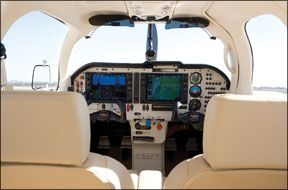
The engine’s full certified capacity is 310-HP, but for the Acclaim, it’s derated to 280 HP by dint of limited RPM, power it can maintain to the airplane’s critical altitude of about 21,000 feet.
Turbonormalizing is a departure for Mooney, as both previous turbo variants were ground boosted-the M20K/231/ 252 and the TLS/Bravo. Why not go for broke and crank it up to the full 310-HP, as Mooney in fact does in the Ovation 3, a normally aspirated model whose prop governor allows 2700 RPM?
Marketing shtick, mostly. Mooney’s claim to fame has always been getting more speed out of less horsepower than anyone else and no one else is currently flying 220-knots with a stated 280 maximum HP. In reality, the Acclaim is turbonormalized only in name, since it in fact does ground boost during the climb.
Cabin Ergonomics
Mooneys are said to be an acquired taste and the company maintains itself as having niche appeal. Frankly, were not sure why this is so. The Acclaim has decent useful load 957 pounds in the demonstrator we flew blazing speed and terrific range. Yes, the cabin is smaller than a Bonanza, a Cirrus or a Cessna, but not by much. We think modern Mooneys have better seats than the aforementioned three, with fully adjustable height, gobs of fore-and-aft slide, adjustable recline and unlimited legroom, although constricted side to side by the center console. The front seats are also equipped with AmSafes airbag system (see
Aviation Consumer January 2007) which fits compactly on the lapbelt and is unnoticeable when fastened.In one of the more practical appointments in light aircraft, the rear seats both
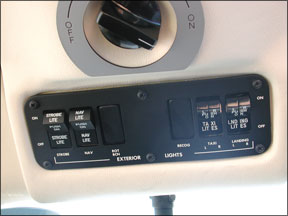
recline and tilt forward when the lower seat pans are removed, creating one enormous baggage space for golf clubs and other unwieldy cargo.
If the airplanes themselves are an acquired taste, ingressing and egressing them is a practiced art. There’s no elegant way to do it; you just have to shimmy past the seats and land your rump where it belongs. Limber little people slip right in; those wide of girth have to wiggle, especially for the backseat.
But once youre in, the creature comforts are excellent. Up front, there’s a gale of ventilation from vents in the overhead and cabin sidewalls, both with nicely appointed eyeball vents. Rear seat passengers have the same, plus small individually switchable reading lights. We inspected these details carefully and found the fit and finish to be excellent.
Rather than the conventional exhaust heater muff, the Acclaims heater pulls bleed air off the turbos through sonic nozzles. These flow generous warm air but also contribute a noticeable hiss in the cockpit, raising the noise level a full decibel. Otherwise, we found cabin noise to be about 92.5 dB in the front and 92 dB in the rear. Its neither the noisiest cabin weve been in nor the quietest.
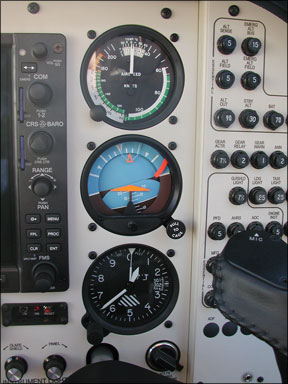
With all of the primary instruments contained in the Garmin G1000, the panel is relatively austere, with just master and emergency bus switches, rudder trim rocker and boost pump switches on the pilots side. There’s more than enough room for the external lighting switches somewhere on the panel, but Mooney put them on the overhead, where its just possible for an aging presbyope to read the labels. Fortunately, there are only four switches, so memorizing position and function should be easy.
Visibility over the glareshield is noticeably better than in the earlier Ovations and the Bravo because Mooney has lowered the height of the panel by more than two inches, something thats especially welcome when taxiing at night. The higher glareshields were an undesireable carryover from the Porsche Mooney days that has finally been corrected.
One aspect of the panel design that caught our eye as dubious is the location of the three required backup steam gauges to the far right of the panel, between the G1000s MFD and the CB panel. But Mooneys veteran demo pilot and salesman, Wayne Fischer, insisted that you get used to it and the fact that theyre out of immediate view forces quicker transition to the glass panel, since many pilots use the steam gauges as crutches. Hes right. The steam gauges are easy enough to scan from the left seat, even if other manufacturers place them on the pilots side.
Performance
A recent press release from Mooney harbored no reticence about the Acclaims speed: “The debate is over. Now there’s no question which single-engine piston airplane can claim the title as the fastest since the Acclaim clearly boasts the highest maximum cruise speed.” But is it really? Columbia makes the same claim for its 400. If it isn’t a tie, someone is just wrong.
Unfortunately, we cant settle the issue just yet. Mooneys Web site claims 237 knots at FL250, the airplanes max certified altitude. The POH we reviewed shows max cruise-power speeds of 233 knots at FL250, but Fischer told us hes seen 237 knots with the throttle firewalled.
The airplane we flew was equipped only with cannulas, not masks, and after conferring with Fischer, we both agreed to place discretion before valor and limit our speed trials to FL200 where, frankly, the airplane is plenty fast.
In our view and were hearing broad consensus on this the most sensible altitudes for non-pressurized turbocharged singles are between 12,000 feet and the mid- to high teens, say 17,500 feet. This represents the best practical compromise between the airplanes high-altitude speed and the real physiological threat that exists above FL200. Go higher and you’ll go faster, but in our estimation, the gain isn’t worth the risk.
Our trials of the Acclaim indicate that it hits its book numbers, plus a bit. At 12,000 feet in ISA +15 degrees, we recorded 208 knots true at 20 GPH, leaned to the recommended 50 degrees rich of peak. At this setting, the warmest CHT was 365 degrees, with the rest 25 degrees cooler. We noticed no slow-trend upward in CHTs, but we stabilized for under 10 minutes. The POH allows lean-of-peak operation (50 degrees LOP) for best economy up to 22,000 feet; above that, only rich of peak is authorized. The LOP setting yielded 201 knots, at 17.5 GPH with the warmest CHT at 351 degrees F.
At 17,500 feet, we saw 219 knots on 20.3 GPH on the rich side, a bit better than the POH numbers, with the warmest CHT at 370 degrees F. On the lean side, the speed was 212 knots on 17.3 GPH. At the highest altitude we tried FL200 we recorded 226 knots on 20.3 GPH rich, again a couple of knots better than POH. LOP operation at that high altitude yielded 218 knots on 17.3 gallons.
As published, Mooneys leaning schedule is potentially more aggressive than its competitors, the Cirrus turbonormalized SR22 and the Columbia 400. Although the CHTs were cool enough in the Acclaim when rich of peak, we think it makes more sense to operate the airplane on the lean side. Well examine that in detail in a future article.
Whether the Acclaim bests the Columbia 400 for top speed is debatable, but with 130 gallons of fuel available, it crushes its competition in range potential. In lean-of-peak mode, its still air range with 45-minute reserve at 17,500 feet is about 1400 miles with the big tanks and about 1025 with standard 102-gallon tanks, without resorting to heroic max range efforts. With a winter tailwind and a stingy power setting, an owner could knock off most of 2000 miles in a single leg.
Conclusion
For all its fiscal trials and travails, Mooney has always been and remains proficient at modernizing the underlying soundness of a 60-year design concept. The Acclaim is as refined as anything Mooney or anyone else has built, in our view. Its a thoroughly likeable airplane.
We have a couple of nits. One is the juxtaposition of the long-range tanks, AC and TKS which, taken together, sap the airplanes load capacity. The Acclaim will be exposed to icing year around so we think adding TKS is a must. Adding the big tanks and air conditioning will eat into range and payload flexibility. Keeping the TKS fluid level low will help that and you typically don’t need much of it. In reality, with the big tanks and TKS, the airplane is suitable only for Lone Ranger missions with an overnight bag.
Second, we profoundly wish Mooneys Web site didnt make the claim that 237 knots is “normal cruise” at FL250. Continuous cruise at this altitude is unrealistic and, in our view, an undertaking of too high a risk to make it worth any benefits. Dragging the airplane to those altitudes just to surpass the Joneses strikes us as a fools game.
In any case, Mooneys have always been more about efficiency and optimization rather than raw speed. (Bonanzas have generally been faster, but rarely more economical.) And in that regard, even lean of peak, the Acclaim slides past the Cirrus SR22 in cruise speed and, with long-range tanks, probably outdistances the Columbia by a state line or two. And getting past either of those formidable airplanes never mind
both of them is no mean feat, thus lofty claims about being the fastest single seem unnecessary.CONTACTS…
Mooney Airplane Co.
800-456-3033
www.mooney.com

